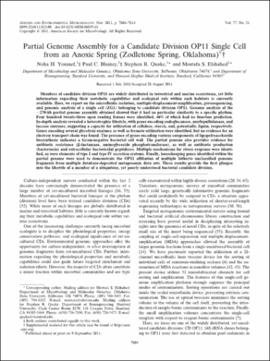| dc.contributor.author | Youssef, Noha H. | |
| dc.contributor.author | Blainey, Paul C. | |
| dc.contributor.author | Quake, Stephen R. | |
| dc.contributor.author | Elshahed, Mostafa S. | |
| dc.date.accessioned | 2018-08-29T14:24:32Z | |
| dc.date.available | 2018-08-29T14:24:32Z | |
| dc.date.issued | 2011-11 | |
| dc.identifier | oksd_youssef_partialgenomea_2011 | |
| dc.identifier.citation | Youssef, N. H., Blainey, P. C., Quake, S. R., & Elshahed, M. S. (2011). Partial genome assembly for a candidate division OP11 single cell from an anoxic spring (Zodletone Spring, Oklahoma). Applied and Environmental Microbiology, 77(21), 7804-7814. https://doi.org/10.1128/AEM.06059-11 | |
| dc.identifier.uri | https://hdl.handle.net/11244/301610 | |
| dc.description.abstract | Members of candidate division OP11 are widely distributed in terrestrial and marine ecosystems, yet little information regarding their metabolic capabilities and ecological role within such habitats is currently available. Here, we report on the microfluidic isolation, multiple-displacement-amplification, pyrosequencing, and genomic analysis of a single cell (ZG1) belonging to candidate division OP11. Genome analysis of the ~270-kb partial genome assembly obtained showed that it had no particular similarity to a specific phylum. Four hundred twenty-three open reading frames were identified, 46% of which had no function prediction. In-depth analysis revealed a heterotrophic lifestyle, with genes encoding endoglucanase, amylopullulanase, and laccase enzymes, suggesting a capacity for utilization of cellulose, starch, and, potentially, lignin, respectively. Genes encoding several glycolysis enzymes as well as formate utilization were identified, but no evidence for an electron transport chain was found. The presence of genes encoding various components of lipopolysaccharide biosynthesis indicates a Gram-negative bacterial cell wall. The partial genome also provides evidence for antibiotic resistance (B-lactamase, aminoglycoside phosphotransferase), as well as antibiotic production (bacteriocin) and extracellular bactericidal peptidases. Multiple mechanisms for stress response were identified, as were elements of type I and type IV secretion systems. Finally, housekeeping genes identified within the partial genome were used to demonstrate the OP11 affiliation of multiple hitherto unclassified genomic fragments from multiple database-deposited metagenomic data sets. These results provide the first glimpse into the lifestyle of a member of a ubiquitous, yet poorly understood bacterial candidate division. | |
| dc.format | application/pdf | |
| dc.language | en_US | |
| dc.publisher | American Society for Microbiology | |
| dc.rights | This material has been previously published. In the Oklahoma State University Library's institutional repository this version is made available through the open access principles and the terms of agreement/consent between the author(s) and the publisher. The permission policy on the use, reproduction or distribution of the material falls under fair use for educational, scholarship, and research purposes. Contact Digital Resources and Discovery Services at lib-dls@okstate.edu or 405-744-9161 for further information. | |
| dc.title | Partial genome assembly for a candidate division OP11 single cell from an anoxic spring (Zodletone Spring, Oklahoma) | |
| osu.filename | oksd_youssef_partialgenomea_2011.pdf | |
| dc.description.peerreview | Peer reviewed | |
| dc.identifier.doi | 10.1128/AEM.06059-11 | |
| dc.description.department | Microbiology and Molecular Genetics | |
| dc.type.genre | Article | |
| dc.type.material | Text | |
| dc.subject.keywords | bacteriocins | |
| dc.subject.keywords | gram-negative bacteria | |
| dc.subject.keywords | heterotrophic processes | |
| dc.subject.keywords | hot springs | |
| dc.subject.keywords | membrane transport proteins | |
| dc.subject.keywords | oklahoma | |
| dc.subject.keywords | open reading frames | |
| dc.subject.keywords | phylogeny | |
